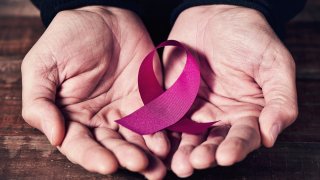

The following content has been created in partnership with Trinity Health Of New England. This content does not represent the opinions of the NBC Connecticut editorial team. Click here to learn more about Trinity Health Of New England.
One in eight U.S. women will be diagnosed with breast cancer in their lifetime, according to the Susan G. Komen Foundation. But this is not just a national issue—as of 2021, breast cancer has become the most common type of cancer globally, as well as the leading cause of cancer death among women.
There are, however, some healthy practices a woman can adopt to reduce risk of developing the disease, including:
Get Connecticut local news, weather forecasts and entertainment stories to your inbox. Sign up for NBC Connecticut newsletters.
Limiting alcohol
Alcohol can significantly elevate estrogen levels, which are regularly associated with an increased risk of breast cancer. Estrogen levels tend to be higher in women who drink alcohol than in non-drinkers.
Even small amounts of alcohol can put one at risk, so consider avoiding it altogether or limiting yourself to no more than three per week, as recommended by the Dana-Farber Cancer Institute.
Changing up diets
Replacing low-nutrient foods like refined carbs, processed meats, and added sugar with richer and fuller meals is good for your overall health. While there are many ways to go about choosing healthier options for your meals, experts agree that you can’t go wrong by eating more plants (especially leafy green vegetables) and less meat, increasing Omega-3 fatty acid intake (including fish, shrimp, oysters, chia seeds, flax seeds, and walnuts). Many women also opt for a Mediterranean diet, which includes a low intake of meat and dairy and is high in grains, vegetables, legumes, fruits, nuts, and unsaturated fats.
Note that these changes and substitutions aren’t that much different from diet plans used to lose weight or stay healthy. These food plans are thought to reduce the risk of developing many illnesses, including some cancers, diabetes, and heart disease.
Maintaining a healthy weight
As previously mentioned, higher levels of estrogen can be associated with a higher breast cancer risk. As a woman ages, most of her estrogen comes from fat tissue, meaning the more fat tissue she has in her body, the more estrogen it will produce.
Avoiding smoking
Breast cancer is only one of the many consequences that may come from smoking. Cigarette smoking can increase breast cancer risk in younger, premenopausal women, especially women who start smoking from a young age. In fact, women who start smoking after their first menstrual period but 11 or more years before having their first child are 45 percent more likely to be diagnosed with breast cancer than women who’ve never smoked.
Soaking up some vitamin D
Because sun exposure is one of its best sources, vitamin D is often referred to as the “sunshine vitamin.” Spending a little time out in the sun may seem easy enough, yet it can still do wonders for your health. Some studies suggest that vitamin D intake reduces the risk of developing some cancers.
Screening frequently
While the above are some practices a woman can adopt to reduce her risk of developing breast cancer, it’s still imperative to schedule a yearly mammogram. While screening regularly doesn’t prevent cancer, it’s saved over half a million lives in the United States. This is because screenings can find breast changes that could be cancer years before physical symptoms develop. Early detection allows for easier treatment—when breast cancer is detected early and is in the localized stage, the five-year relative survival rate is of 99 percent, according to the American Cancer Society. However, only 63 percent of women with breast cancer are diagnosed at this stage, mainly because many fail to schedule their regular mammograms. Keep in mind that many women with breast cancer don’t show any symptoms, so regular breast cancer screening is crucial for detection and can make a life-or-death difference.
Mammograms are low-dose X-rays of the breast and the most common type of preventive screenings. A newer type of mammogram called digital breast tomosynthesis (also known as three-dimensional mammography) has become much more common recently, as it appears to lower the chance of being called back for follow-up testing.
Another type of screening used is the Breast MRI, which uses magnets and radio waves to take pictures of the breast. This MRI is not as common as the mammogram because it’s usually reserved for higher-risk women, since the imaging may show abnormalities even when there is no cancer. The American Cancer Society therefore advises against MRI screening for women whose lifetime risk of breast cancer is less than 15 percent.
It’s recommended that women should have the opportunity to begin screening between the ages of 40-44, with regular screenings beginning at 45. Women over 55 can choose whether they want to continue this trend or switch their mammograms to every other year, however, they should do this under consultation with their physician. Younger women may also get screened, especially if they’re at a higher risk of developing the disease due to family history, genetic, or environmental factors.
Early detection is key when it comes to breast cancer. For more information on breast cancer prevention and detection, visit Trinity Health Of New England. Click here to learn more about Trinity Health Of New England.

